

The 'Little Trains of Austria' with Leger is a holiday that we have been planning to do for several years. It is one of John and Tony's favourites and finally everything came together and we spent a great week in the beautiful Austrian Tyrol with our friends Nick and Olwen and our best drivers, John and Tony. The trains are purported to have been introduced into Austria by the Emperor Franz Joseph who reigned from 1848 until 1916 so that the ordinary people of Austria would be able to travel to see the mountains and valleys of the Tyrol.
We stayed at the Hotel Sonnschein in the town of Niederau located in the Wildschönau Valley, which as well as a ski resort in winter is also a most beautiful place to visit in the summer. We have stayed here several times as an overnight stop on the way back from somewhere else as it is very popular with Leger travellers, but this is the first time we have spent some time in this typical Austrian hotel owned by Herbert and his English wife Gill.
The first train we went on was the Zillertal which was opened in 1902 to provide a service for residents of the upper Ziller valley to get to the main line station in Jenbach. Most of the passenger train services operate using modern diesel locomotives and carriages but the Zillertal Railway also has several steam locomotives which are used with heritage rolling stock for special trains targeting tourists.
An interesting fact is that some of the Zillertal Railway's redundant rolling stock was donated to the Welshpool and Llanfair Light Railway in the UK (see the likeness of the Welsh train inset right to the Jenbach train in the photos). The Zillertal is an unexpected mix of old and modern; since 2005 points on the line have been remotely controlled from the Jenbach control centre using fibre optic transmission.
We enjoyed our day starting in the town of Mayrhofen and ending after the train journey in the picturesque town of Fugen.
Prior to our journey on the Pinzgau train we stopped off in Kitzbuhl, the resort of the rich and famous, which has the longest illuminated toboggan run in the world and a lot of very expensive cars parked outside the shops; other than that not much to say about it and we were soon on our way through the Thurn Pass to catch the Pinzgau train which took us from Mittershill to the town of Krimml. One of the things that you are not told is to stand upwind of the train otherwise you get covered in black soot from the smoke coming out of the funnel. The Pinzgaubahn, often called the most attractive narrow-gauge railway in Austria, takes you through one of the most beautiful parts of the Alps along the foot of the high mountains of the national park "Hohe Tauern".
When we reached Krimml, our drivers took us to the waterfalls; with a total drop of about 380 metres these waterfalls are among Europe's highest and present a quite stunning sight for the tourist (see video below). Archaeological findings here have shown settlements from the Early Bronze Age and it was known to be part of the Celtic kingdom of Noricum from about 200 BC. Like much of the countries bordering Italy the area was incorporated into the Roman Empire from the 15th until the 5th century BC. Along with the waterfalls in the Plitvice national park this is one of my favourite natural wonders.
The Schafberg Railway is a cog railway, similar to the Jensbach, in Upper Austria and Salzburg starting at Sankt Wolfgang im Salzkammergut travelling up to the Schafberg mountain(1,783 m); the railway gains about 1,200 m in height over approximately 5.85 km in distance and has been operating since 1893. Prior to the train journey we had already visited the picturesque town of St Gilgen in the Saltzkemmergut area, known as the Austrian lake district, and taken a lake cruise to St Wolfgang. Although St Gilgen has been promoted as the Mozart Village, in fact Mozart never visited the town where his grandfather worked and his mother was born. We were blessed with great weather for our lake cruise and the train ride to the top of the Schaffberg.
For our final train journey we took the Jenbach railway which runs from Jenbach to Seespitz which is on the shore of Lake Achensee. The Jenbach is a typical rack and pinion railway designed for pulling a train up a steep incline. It uses a toothed rack rail in-between the running rails whilst the trains are fitted with one or more cog wheels or pinions that mesh with this rack rail. This allows the trains to operate on steep grades above around 7 to 10%, which is the maximum for a normal friction-based rail. The Jenbach railway consists of a 100 year old narrow gauge steam engine and either two or three equally old carriages fitted with wooden bench seating; both the trains and the carriages are beautifully maintained. The journey takes about 50 minutes each way and the train climbs a steep gradient up the mountain, a rise of 440 metres over seven kilometres, passing through four smaller stations(halts) on the way eventually arriving at the lake.
Lake Achensee is no doubt a beautiful place to visit but unfortunately the weather was poor on the day we were there so we didn't see the best of it but it has always been a major attraction for people from all walks of life including in their day Emperor Maximilian I and Archduke Ferdinand II, who had luxury boats moored there. In spite of the rain we found a suitable hostelry to enjoy lunch and a few lemonades with our friends.
Innsbruck is the capital of the Tyrol and of course has the famous Bergisel ski-jump seen in the winter olympics. The hill itself is a historic site, scene of the 1809 battles in which Andreas Hofer led some Tyrolean peasants against French and Bavarian forces in the Tyrolean War of Independence. The first ski jump was erected here in the year 1925 and in 1964 and 1976, the Innsbruck Ski Jump was venue of the Olympic Ski Jumping competitions. The jump has been redesigned since (2002) and includes many other features; the tower itself stands 47 meters tall and provides spectacular views over the valley
Innsbruck also has the famous 'Golden Roof' or Goldenes Dachl which was constructed by Archduke Friedrich IV in the early fifteenth century as the residence of the Tyrolean sovereigns. Designed and constructed by Nikolaus Turing the Elder in 1493, the Innsbruck court builder, at the time of Maximillian's marriage to Bianca Maria Sforza, the 'golden roof' is made from 2,657 fire-gilded copper tiles. It was designed primarily to serve as a royal box where the Emperor and his imperial entourage could sit in state and enjoy festivals, tournaments, and other events that took place in the square below. Not wishing to alienate the allies gained by his first marriage, to Maria of Burgundy, he had an image of himself between the two women painted on his balcony. In March 2017, Bollywood actors Salman Khan and Katrina Kaif used the Goldenes Dachl as a part of the shooting for the action packed spy romance movie Tiger Zinda Hai (I bet you didn't know that!).
This was by the Nordkettenbahnen cable car and gave us a magnificent view over the city of Innsbruck and the Middle Inn Valley as far as the Zillertal Valley Alps. We could have taken the secondary cable car (shown in one of the photos) up to the highest point (2,256 metres) but as we couldn't see the top (shrouded in mist) we decided to give that a miss. Instead as you can see from the photos and the image (right) it was playtime for the children at the top of the Hungerford.
We've been to Saltzburg before on a Leger holiday but this time we decided to please ourselves when we arrived whereas in the past we have had a guide. During the day we went up by cable car to the Hohensaltzburg fortress at the top of the hill and basically just wandered around and relaxed.
When we returned to ground level we walked through the Petersfriedhof or St Peter's cemetary which dates back as far as 700 when the adjacent St. Peter's Abbey was established by Saint Rupert of Salzburg. The abbey's cemetery, has tombs dating back to 1288 and is famous as the place the Von Trapp hid out in the Sound of Music. There are many well know historical figures buried here including Mozart's sister Nenneri and Joseph Haydn's brother Michael, Santino Solari (designed and built Salzburg Cathedral) and Harry Collins who was the last commander of the American occupying forces; he later lived in Salzburg and became one of the city’s honorary citizens. Unsurprisingly, this is a tourist favourite, a beautiful old cemetery that is looked after with loving care by Saltzburg's citizens.
The night before we left the hotel, as stand in for the entertainer who was unable to make it first of all Herbert the owner gave us a rendition of Allouette, whilst playing the harp, using his own lyrics. This was followed by Eric and Tony singing the 'Little Jimmy Brown' song. Eric then went solo with a little liquid refreshment provided by Jane (see videos below). A very enjoyable evening of cabaret for which we have to thank Herbert and the Sonnschein as well of course Eric and Tony, who didn't really want to do it but did so for our benefit...thank you to everyone at the Sonnschein.
We had a final day of leisure before coming home and as it was a beautiful day we decided to go up the cable car from the centre of Niederau near the hotel to the top of the Markbachjoch mountain. We had already seen the paragliders taking off from the top of the montain and wanted to see them close up. The paragliders painstakenly laid out their chutes before running to catch the wind and serenely glide off down to the bottom - I wish I was younger, it looks great fun.
In the afternoon we took a ride in the Bummelbahn, which is a sort of a road train, driven by Eric that took us along the Wildschonnau Valley from Niederau to Auffach (875m above sea level). The name Auffach originated from the timber industry when years ago the village was a timber rafting centre; appropriately, there's a small timber built chapel (very well built I might add with some massive dove-tail joints) at the end of the valley. When we arrived back at the hotel John and Tony had organised a trip in a horse drawn wagon along the valley where we were supplied with copious amounts of Schnapps.
We set off the following day with John and Tony having enjoyed a superb holiday at the Sonnschein with Leger; we love this typical Austrian hotel and every room is superb, completely different to the standard hotels we stay in these days. We took daily dips in the indoor pool and enoyed almost everything about the hotel from the accommodation and food to the fantastic views of the valleys and the mountains.
On the way home we had an unexpected treat when we stopped for a few hours at Rottenburg-ob-der-Tauber which means Red Fortress above the Tauber (rot or red and burg, a medieval fortified settlement). Rottenburg is a beautiful old medieval town and part of the Romantic Road which is a "theme route" devised by promotion-minded travel agents in the 1950s to describe the 350 kilometres between Würzburg and Füssen in southern Germany. The road links a number of picturesque towns and castles which formed a trade route in medieval times and possess "quintessentially German" scenery and culture; the Romantic Road is marked along the way with brown signs.
What made this such a great experience though was that there was a fair in progress and the highlight of this was a performance of song and dance in the town square by a large group of musicians and dancers - quite wonderful (see video below).
In addition there is a famous christmas shop just off the square, small on the outside but like the tardis, big inside. We just had time before getting back on the coach to have lunch, visit the christmas shop and watch the orchestra in action (an American group I think). It was the unexpectedness of the day that really made it a memorable experience.
Our final stop before the long journey home was at Bopard where most of the group went on the river cruise up the Rhine; we had already done this same trip last year and decided to give it a miss and have a look round the town of Bopard which was pleasant enough and gave us a chance to relax for a couple of hours in a suitable hostelry. When the party returned and we were waiting for the coach a few idiots decided to have a splash in the small rock pool; this proved a bad move for Nick who cut his big toe which then turned sceptic and had to have treatment back home and time off work.
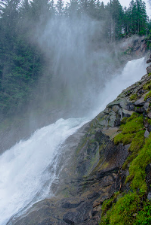 Krimml Waterfall |
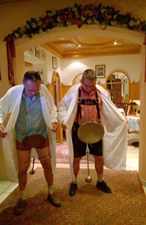 Cabaret |
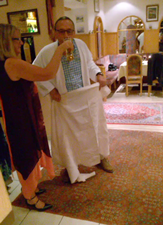 Eric in Cabaret |
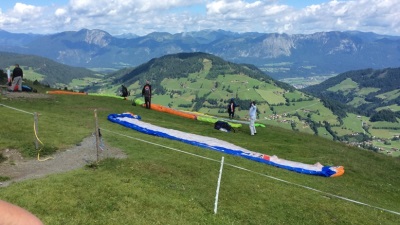 Paragliding in the Tyrol |
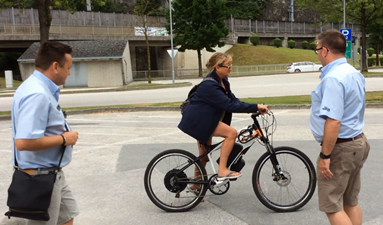 Jane testing Tony's Electric Bike |
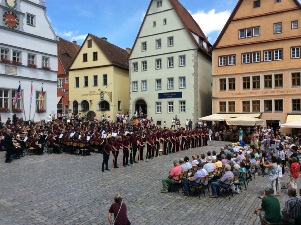 Youth Orchestra at Rottenburgh |